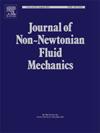弹粘塑性流体中气泡靠近壁面的上升和迁移动力学
IF 2.8
2区 工程技术
Q2 MECHANICS
引用次数: 0
摘要
我们利用三维直接数值模拟研究了弹粘塑性(EVP)流体中靠近垂直固体壁面上升的气泡的浮力驱动运动。EVP流变学通过Saramito-Herschel-Bulkley方程建模,捕捉粘性、弹性和塑性行为。与先前的实验和数值结果的验证表明,无界域具有良好的一致性。附近的壁面诱导了向气泡的横向迁移,其速度取决于壁面距离、气泡体积和流体流变。对于较大的气泡,其中惯性占主导地位,横向速度始终为正,表明持续的壁面排斥,并随着壁面距离的增加而减小。在很长一段时间内,横向和垂直速度都集中在一条主曲线上,仅取决于瞬时壁距。相比之下,受弹性效应支配的小气泡表现出非单调的横向速度:靠近壁面为正,但在较大距离处为负,表明存在平衡的横向位置。参数化研究强调了可变形性在调节迁移动力学中的作用。更多可变形的气泡表现出更强的排斥力和上升速度,这取决于终端形状:大的、扁圆形的气泡由于在流动方向上的截面增加而上升得更慢,而较小的泪滴状气泡上升得更有效。增加屈服应力增强了弹性响应,使侧向平衡距离更靠近壁面。相反,降低弹性模量(软化介质)会增加终端速度并增强壁面斥力。最后,初始气泡形状和取向的变化会影响瞬态变形,但对长期迁移或最终状态的影响可以忽略不计。本文章由计算机程序翻译,如有差异,请以英文原文为准。
Rising and migration dynamics of an air bubble close to a wall in an elastoviscoplastic fluid
We investigate the buoyancy-driven motion of an air bubble rising near a vertical solid wall in an elastoviscoplastic (EVP) fluid using three-dimensional direct numerical simulations. The EVP rheology is modelled via the Saramito-Herschel-Bulkley equation, capturing viscous, elastic, and plastic behaviour. Validation against prior experimental and numerical results for unbounded domains shows excellent agreement. The nearby wall induces a lateral migration to the bubble, with the velocity depending on wall distance, bubble volume, and fluid rheology. For larger bubbles, where inertia dominates, the lateral velocity is consistently positive, indicating persistent wall repulsion, and decreases with increasing wall distance. At long times, both lateral and vertical velocities collapse onto a master curve, depending only on the instantaneous wall distance. In contrast, smaller bubbles, dominated by elastic effects, exhibit a non-monotonic lateral velocity: positive near the wall but negative at larger distances, indicating the existence of an equilibrium lateral position. A parametric study highlights the role of deformability in modulating migration dynamics. More deformable bubbles show enhanced repulsion and rising velocities that depend on terminal shape: large, oblate bubbles rise more slowly due to increased cross section in the direction of flow, while smaller teardrop-shaped bubbles rise more efficiently. Increasing the yield stress strengthens the elastic response, shifting the lateral equilibrium distance closer to the wall. Conversely, decreasing the elastic modulus (softening the medium) increases the terminal velocity and enhances wall repulsion. Finally, variations in initial bubble shape and orientation affect transient deformation but have negligible influence on long-term migration or terminal state.
求助全文
通过发布文献求助,成功后即可免费获取论文全文。
去求助
来源期刊
CiteScore
5.00
自引率
19.40%
发文量
109
审稿时长
61 days
期刊介绍:
The Journal of Non-Newtonian Fluid Mechanics publishes research on flowing soft matter systems. Submissions in all areas of flowing complex fluids are welcomed, including polymer melts and solutions, suspensions, colloids, surfactant solutions, biological fluids, gels, liquid crystals and granular materials. Flow problems relevant to microfluidics, lab-on-a-chip, nanofluidics, biological flows, geophysical flows, industrial processes and other applications are of interest.
Subjects considered suitable for the journal include the following (not necessarily in order of importance):
Theoretical, computational and experimental studies of naturally or technologically relevant flow problems where the non-Newtonian nature of the fluid is important in determining the character of the flow. We seek in particular studies that lend mechanistic insight into flow behavior in complex fluids or highlight flow phenomena unique to complex fluids. Examples include
Instabilities, unsteady and turbulent or chaotic flow characteristics in non-Newtonian fluids,
Multiphase flows involving complex fluids,
Problems involving transport phenomena such as heat and mass transfer and mixing, to the extent that the non-Newtonian flow behavior is central to the transport phenomena,
Novel flow situations that suggest the need for further theoretical study,
Practical situations of flow that are in need of systematic theoretical and experimental research. Such issues and developments commonly arise, for example, in the polymer processing, petroleum, pharmaceutical, biomedical and consumer product industries.

 求助内容:
求助内容: 应助结果提醒方式:
应助结果提醒方式:


